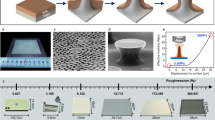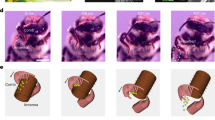Abstract
Adhesion strategies that rely on mechanical interlocking or molecular attractions between surfaces can suffer when coming into contact with liquids1,2. Thus far, artificial wet and dry adhesives have included hierarchical mushroom-shaped or porous structures that allow suction or capillarity3,4,5,6, supramolecular structures comprising nanoparticles7, and chemistry-based attractants that use various protein polyelectrolytes8,9,10. However, it is challenging to develop adhesives that are simple to make and also perform well—and repeatedly—under both wet and dry conditions, while avoiding non-chemical contamination on the adhered surfaces11. Here we present an artificial, biologically inspired, reversible wet/dry adhesion system that is based on the dome-like protuberances found in the suction cups of octopi. To mimic the architecture of these protuberances12,13,14, we use a simple, solution-based, air-trap technique that involves fabricating a patterned structure as a polymeric master, and using it to produce a reversed architecture, without any sophisticated chemical syntheses or surface modifications. The micrometre-scale domes in our artificial adhesive enhance the suction stress. This octopus-inspired system exhibits strong, reversible, highly repeatable adhesion to silicon wafers, glass, and rough skin surfaces under various conditions (dry, moist, under water and under oil). To demonstrate a potential application, we also used our adhesive to transport a large silicon wafer in air and under water without any resulting surface contamination.
This is a preview of subscription content, access via your institution
Access options
Access Nature and 54 other Nature Portfolio journals
Get Nature+, our best-value online-access subscription
$29.99 / 30 days
cancel any time
Subscribe to this journal
Receive 51 print issues and online access
$199.00 per year
only $3.90 per issue
Buy this article
- Purchase on Springer Link
- Instant access to full article PDF
Prices may be subject to local taxes which are calculated during checkout




Similar content being viewed by others
References
Lee, H., Lee, B. P. & Messersmith, P. B. A reversible wet/dry adhesive inspired by mussels and geckos. Nature 448, 338–341 (2007)
Isrealachvili, J. Intermolecular and Surface Forces (Academic, 1991)
Dirks, J.-H. & Federle, W. Fluid-based adhesion in insects—principles and challenges. Soft Matter 7, 11047–11053 (2011)
Xue, L., Kovalev, A., Eichler-Volf, A., Steinhart, M. & Gorb, S. N. Humidity-enhanced wet adhesion on insect-inspired fibrillar adhesive pads. Nat. Commun. 6, 6621 (2015)
Chen, Y., Shih, M.-C., Wu, M.-H., Yang, E.-C. & Chi, K.-J. Underwater attachment using hairs: the functioning of spatula and sucker setae from male diving beetles. J. R. Soc. Interface 11, 20140273 (2014)
Kovalev, A. E., Varenberg, M. & Gorb, S. N. Wet versus dry adhesion of biomimetic mushroom-shaped microstructures. Soft Matter 8, 7560–7566 (2012)
Rose, S. et al. Nanoparticle solutions as adhesives for gels and biological tissues. Nature 505, 382–385 (2014)
Zhao, Q. et al. Underwater contact adhesion and microarchitecture in polyelectrolyte complexes actuated by solvent exchange. Nat. Mater. 15, 407–412 (2016)
Lee, S.-B., González-Cabezas, C., Kim, K.-M., Kim, K.-N. & Kuroda, K. Catechol-functionalized synthetic polymer as a dental adhesive to contaminated dentin surface for a composite restoration. Biomacromolecules 16, 2265–2275 (2015)
White, J. D. & Wilker, J. J. Underwater bonding with charged polymer mimics of marine mussel adhesive proteins. Macromolecules 44, 5085–5088 (2011)
Kim, D.-H. et al. Epidermal electronics. Science 333, 838–843 (2011)
Tramacere, F. et al. The morphology and adhesion mechanism of Octopus vulgaris suckers. PLoS One 8, e65074 (2013)
Tramacere, F., Kovalev, A., Kleinteich, T., Gorb, S. N. & Mazzolai, B. Structure and mechanical properties of Octopus vulgaris suckers. J. R. Soc. Interface 11, 2013 0816 (2013)
Tramacere, F., Pugno, N. M., Kuba, M. J. & Mazzolai, B. Unveiling the morphology of the acetabulum in octopus suckers and its role in attachment. Interface Focus 5, 20140050 (2014)
Smith, A. Cephalopod sucker design and the physical limits to negative pressure. J. Exp. Biol. 199, 949–958 (1996)
Laulicht, B., Langer, R. & Karp, J. M. Quick-release medical tape. Proc. Natl Acad. Sci. USA 109, 18803–18808 (2012)
Jeong, H. E., Lee, J.-K., Kim, H. N., Moon, S. H. & Suh, K. Y. A nontransferring dry adhesive with hierarchical polymer nanohairs. Proc. Natl Acad. Sci. USA 106, 5639–5644 (2009)
Afferrante, L., Carbone, G., Demelio, G. & Pugno, N. Adhesion of elastic thin films: double peeling of tapes versus axisymmetric peeling of membranes. Tribol. Lett. 52, 439–447 (2013)
Bullock, J. M. R. Biomechanics of the Fibrillar Adhesive System in Insects. PhD thesis, Univ. Cambridge (2010)
Heepe, L., Varenberg, M., Itovich, Y. & Gorb, S. N. Suction component in adhesion of mushroom-shaped microstructure. J. R. Soc. Interface 8, 585–589 (2010)
Yang, S. Y. et al. A bio-inspired swellable microneedle adhesive for mechanical interlocking with tissue. Nat. Commun. 4, 1702 (2013)
Choi, S.-J., Yoo, P. J., Baek, S. J., Kim, T. W. & Lee, H. H. An ultraviolet-curable mold for sub-100-nm lithography. J. Am. Chem. Soc. 126, 7744–7745 (2004)
Yoo, P. J. et al. Unconventional patterning with a modulus-tunable mold: from imprinting to microcontact printing. Chem. Mater. 16, 5000–5005 (2004)
Acknowledgements
We acknowledge support from the National Research Foundation of Korea (grants NRF-2014R1A1A1007162 and NRF-2016H1A2A1908670). This research was partially supported by a grant from the Korea Health Technology R&D Project (grant HI17C1728), and by a grant from the Institute for Information and Communications Technology Promotion, funded by the Korea government (grant B0132-15-1003, ‘The development of skin adhesive patches for the monitoring and prediction of mental disorders’). S.H.B. was partially supported by the National Research Foundation of Korea, funded by the Ministry of Science, ICT and Future Planning (grant NRF-2015R1C1A1A01055224). We thank D. G. Jo for animal experiments.
Author information
Authors and Affiliations
Contributions
S.B. and C.P. conceived the project. S.B., D.W.K. and Y.P. performed the wet and dry adhesion experiments. S.B., D.W.K., Y.P. and C.P. developed the experimental set-up for adhesion tests. S.B., S.H.B., T.-J.L. and C.P. designed the wound/adhesive experiments, and S.B., T.-J.L. and S.H.B. carried out these experiments. S.B., T.-J.L., S.H.B. and C.P. analysed the data. S.B., S.H.B. and C.P. wrote the paper, and all authors provided feedback.
Corresponding author
Ethics declarations
Competing interests
The authors declare no competing financial interests.
Additional information
Reviewer Information Nature thanks G. Cotsarelis, F. Melchels, J. Wilker and the other anonymous reviewer(s) for their contribution to the peer review of this work.
Publisher's note: Springer Nature remains neutral with regard to jurisdictional claims in published maps and institutional affiliations.
Extended data figures and tables
Extended Data Figure 1 Fabrication of meniscus-assisted structures, and the underlying mechanism of a partial-wetting technique.
a, (i) Fabrication of perforated cylinders by a partial-wetting technique, and of OIAs by moulding from these perforated cylinders. (ii) Patterning of cylindrical pillars and holes without meniscus curvature on their top surfaces. b, Left three panels, underlying mechanism for the partial-wetting technique; right panel, a cross-sectional optical image of a perforated-cylinder structure. V0 is the initial volume; rh is the radius and H is the depth of hole-patterns; γ is the surface tension; θ is the contact angle between the liquid precursor and solid mould; Va is the volume of trapped air; Ra is the radius of curvature of trapped air. The force balance among gas, liquid, and solid interfaces owing to the capillary rise of a liquid precursor and a trapped air bubble in a solid hole-pattern can be controlled by the pump connected in a process chamber (see Supplementary Information for details).
Extended Data Figure 2 Adhesion strengths of OIA adhesives with differently sized features under wet and dry conditions.
a–d, We fabricated s-PUA-based OIAs with three different radii: 15 μm, 50 μm or 150 μm. We tested their adhesion to silicon wafers using different preloads (10–35 kPa), in a, dry; b, moist; c, underwater; and d, under-oil conditions. Error bars represent standard deviations (N = 10).
Extended Data Figure 3 Fluorescence-assisted investigation of surface contamination when using commercial medical tape or our OIA adhesive.
a, The method for inspecting surface contamination, involving adhering a silicon wafer to our OIA adhesive or to commercial medical tape, detaching it, then dipping the wafer in FITC solution and blowing nitrogen gas over it three times in total. b–d, Fluorescent microscopy images of silicon wafers, before attaching adhesives (b) and after attaching and detaching medical tape (c) or our OIA adhesive (d).
Supplementary information
Supplementary Information
This file contains Supplementary Methods, Theory, 1 table, 14 figures and associated references. (PDF 6618 kb)
Application of Octopus-Protuberance-Inspired Adhesive
Example of an OIA adhesive pad (1.0 ×1.5 cm2; 50-μm radius) supporting a large-area, 8-inch wafer under water. The load could be easily detached with an effortless peeling-off technique. (MP4 13737 kb)
Example of clean transportation under water using an OIA adhesive pad
Example of clean transportation under water using an OIA adhesive pad (1.0×1.5cm2; 50-μm radius) (MP4 11505 kb)
Example of an OIA adhesive pad supporting a 0.5-kg weight in wet condition
Example of an OIA adhesive pad (1.0 ×1.5 cm2; 50-μm radius) supporting a 0.5-kg weight in wet condition. (MP4 7341 kb)
Rights and permissions
About this article
Cite this article
Baik, S., Kim, D., Park, Y. et al. A wet-tolerant adhesive patch inspired by protuberances in suction cups of octopi. Nature 546, 396–400 (2017). https://doi.org/10.1038/nature22382
Received:
Accepted:
Published:
Issue Date:
DOI: https://doi.org/10.1038/nature22382
This article is cited by
-
Motion artefact management for soft bioelectronics
Nature Reviews Bioengineering (2024)
-
Development of wet adhesion of honeybee arolium incorporated polygonal structure with three-phase composite interfaces
Friction (2024)
-
Intelligent structured nanocomposite adhesive for bioelectronics and soft robots
Nano Research (2024)
-
Metamaterial adhesives for programmable adhesion through reverse crack propagation
Nature Materials (2023)
-
Getting glued in the sea
Polymer Journal (2023)
Comments
By submitting a comment you agree to abide by our Terms and Community Guidelines. If you find something abusive or that does not comply with our terms or guidelines please flag it as inappropriate.



